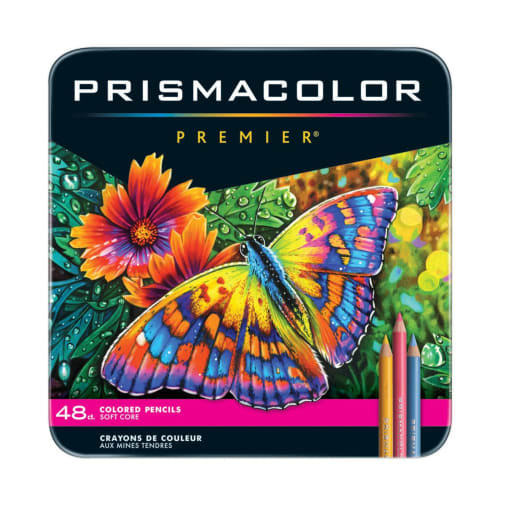These colored pencils have soft cores, which mean they are a wonderful option for projects involving blending, shading, or layering. Strong pencil leads allow you to switch between drawing powerful lines and making gentle shades. 48 ct.
Prismacolor Colored Pencils 48 / set
SKU
007090
Grade 3-AD
These icons are designed to help you quickly understand and learn important information about our products.
Teaching Method
Traditional
Teacher-centered curriculum commonly used in classrooms that may include a text, teacher manual, tests, etc.
Charlotte Mason
A methodology based on the work of a 19th century educator who maintained that children learn best from literature (Living Books), not textbooks.
Classical
A methodology based on the Latin Trivium (three stages of learning), including the grammar stage (memorization and facts), logic stage (critical thinking), and rhetoric stage (developing/defending ideas).
Unit Study
A thematic or topical approach centered around one topic that integrates multiple subject areas.
Montessori (Discovery)
A methodology based on the work of a 20th century educator that emphasizes student and sensory-driven discovery learning and real-life applications.
Other
Other methodologies
Religious Content
Secular
Contains content contrary to common Christian beliefs (i.e. evolution).
Neutral
Avoids religious or theoretical topics or presents multiple viewpoints without preference.
Christian/Religious
Faith-based or including instructional religious content.
Learning Modality
Auditory
Learns through listening, talking out loud or reading out loud.
Visual
Learns through seeing, prefers written instructions and visual materials.
Kinesthetic/Tactile (Hands-On)
Learns through moving, doing and touching.
Multi-Sensory
Curriculum that employ a variety of activities/components.
Presentation
Sequential
Curriculum progresses through well-defined learning objectives. Emphasizes mastery before moving to the next topic.
Spiral
Topics and concepts are repeated from level to level, adding more depth at each pass and connecting with review.
Conceptual/Topical
Focus is on the “why,” often with a unifying concept as well as specific skills; coverage may be broader.
Teacher Involvement
Low Teacher Involvement
Student-led materials; parent acts as a facilitator.
Medium Teacher Involvement
A mix of teacher-led time and independent student work.
High Teacher Involvement
Teacher-led lessons; may utilize discussions, hands-on activities and working together.
Additional Materials Required
No other materials needed
Everything you need is included.
Other Materials Required
There are additional required resources that are a separate purchase.
Other Materials Optional
There are additional resources mentioned or recommended but are not absolutely necessary.
Consumable
Consumable
Designed to be written in; not reusable.
Non-Consumable
Not designed to be written in; reusable.
Our Price
$98.69 $98.69 $75.25
Rainbow Savings: $23.44
Product Overview
- These pencils have soft cores, making them ideal for blending, shading, and layering
- Strong pencil leads allow you to switch between drawing strong lines and making gentle shades
Description
Publisher's Description of Prismacolor Colored Pencils 48 / set
Bring out the soft side of any illustration or art project with Prismacolor Premier Colored Pencils featuring soft cores. Inside the box you’ll find 48 colored pencils featuring creamy cores that are the artist’s choice for blending, shading and layering. Prismacolor pencils have pigments of unmatched quality and leads that are strong enough to be sharpened to a precision point. That means you can effortlessly switch between powerful lines, delicate blends and silky shadowing.
- Soft, thick cores are perfect for shading and shadows
- Ultra-smooth, even color laydown
- Lightfast, richly saturated pigments
- Thick, robust leads resist cracking and chipping making them perfect for adult coloring books
- 48 premium colored pencils
Details
| Product Format: | Other |
|---|---|
| Grades: | 3-AD |
| Brand: | Prismacolor |
| EAN/UPC: | 070735035981 |
| Length in Inches: | 8.125 |
| Width in Inches: | 8.125 |
| Height in Inches: | 1 |
| Weight in Pounds: | 1.2125 |
Videos
Reviews

